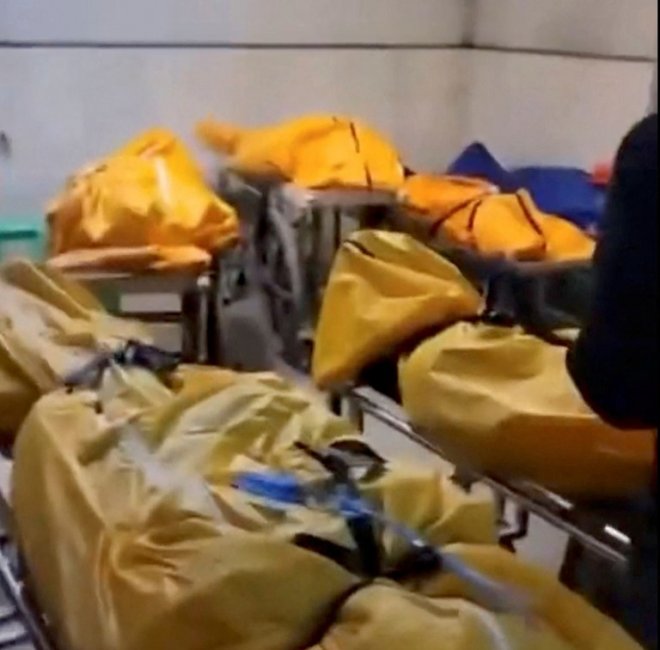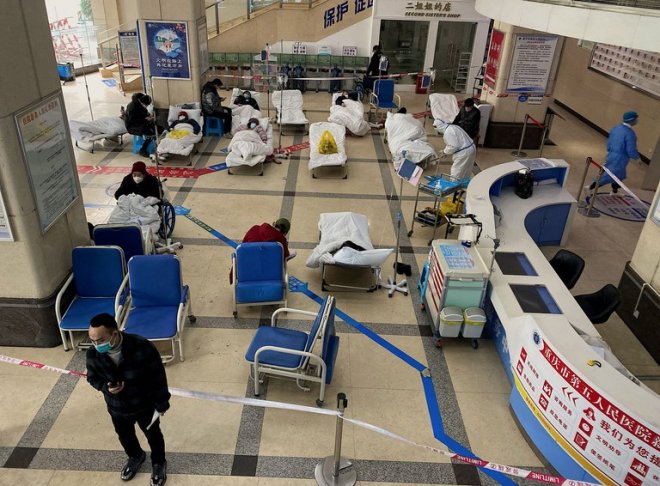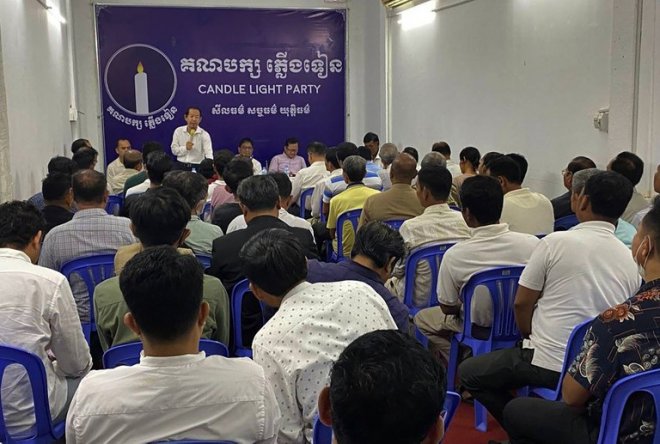Nearly 250 million people in China could have COVID-19, leaked document shows
Nearly 250 million people may now be infected with COVID-19 following the lifting of control measures in China, according to a leaked government document circulating on social media.
The document, which appeared to be the leaked minutes of a Dec. 20 meeting of the country"s National Health Commission, estimated that some 248 million people became infected with COVID-19 from Dec. 1-20, or 17.65 percent of China"s population.
New cases on Dec. 20 alone were estimated at around 37 million, in stark contrast to the mere thousands of cases detailed by official government figures for that day.
A senior Chinese journalist who spoke on condition of anonymity for fear of reprisals told Radio Free Asia on Thursday that the document was genuine, and had been leaked by someone who attended the meeting who was acting deliberately and in the public interest.s
The apparent leak came amid growing anecdotal evidence of a wave of deaths in Beijing, and as the U.K.-based research firm Airfinity estimated that as many as 5,000 people are dying of the coronavirus across the whole of China every day.
The firm had run a computer model based on regional Chinese data to arrive at the figure. The same model put the number of current daily COVID-19 infections at more than a million a day.
Official data is currently reporting a total of 1,800 cases and only seven deaths across the past week, although officials have warned that the virus is now "impossible to track" with the abandonment of mass, compulsory testing.
![]() Several body bags are lined up around the level at a loading bay in a building in Chongqing, China, in this image released Thursday, Dec. 22, 2022. Credit: Reuters screenshot from video
Several body bags are lined up around the level at a loading bay in a building in Chongqing, China, in this image released Thursday, Dec. 22, 2022. Credit: Reuters screenshot from video![]() China"s National Health Commission did not immediately respond to a request for comment, Reuters said in its report on the Airfinity estimates.
China"s National Health Commission did not immediately respond to a request for comment, Reuters said in its report on the Airfinity estimates.
Officials on Thursday reported no new COVID-19 deaths and 2,966 new local symptomatic cases for Dec. 21.
Airfinity"s mortality risk analysis suggested that between 1.3 and 2.1 million people could die in the current outbreak, with other analyses suggesting more than two million deaths, Reuters reported.
Airfinity estimates the outbreak could see two peaks at 3.7 million a day in mid-January in regions where cases are currently rising and 4.2 million a day in March in other provinces.
Cases were currently rising fastest in Beijing and the southern province of Guangdong, it said.
Skyrocketing further
The leaked minutes quote National Health Commission head Ma Xiaowei as saying at an internal meeting that cases will likely skyrocket further now that disease control and prevention measures have largely been lifted, and as people are making the annual trip back to their parental homes to spend Lunar New Year, in what is one of the biggest mass migrations of people on the planet.
It is foreseeable that the number of cases will rise rapidly in more places, with cities and rural areas rising at similar rates, Ma is quoted as saying in the document, which Radio Free Asia was unable to verify independently.
Given that rural areas enjoy much sparser healthcare provision and are frequently home to elderly people with an array of chronic diseases, the situation could worsen considerably once that happens, Ma is cited as saying.
Cases are currently highest in Beijing and the southwestern province of Sichuan, according to the minutes, with cumulative infection rates of more than 50 percent, while Tianjin, Hubei, Henan and Hunan had estimated cumulative infection rates ranging from 20-50 percent.
Around 2.62 percent of the population is believed to have gotten COVID-19 on Dec. 20 alone, with infections spreading rapidly in Sichuan, Anhui, Hubei, Shanghai and Hunan, the document said.
More than 20 million people have been infected so far in Sichuan, with Henan and Hubei estimated to have similar numbers, while 10-20 million people are thought to have been infected in each of Hunan, Hebei, Guangdong, Beijing, Anhui, and Shandong, according to the minutes.
Lin Hsiao-hsu, a former virology researcher at the Walter Reed Army Research Institute in the United States, said the Chinese government is likely to have used its own computer models to generate the figures mentioned in the leaked document, now that there is no more data coming in from testing.
"Reading it, I think all we can really say is that the COVID-19 outbreak has now spread through the whole of China," Lin told Radio Free Asia.
"The fact that the Communist Party has arrived at such huge estimates shows that they are trying to whip up panic, so they can take advantage of it," he said.
Lin said the most worrying development should be the incidence of serious illness and deaths, as well as the current shortage of medicines and medical supplies, including ventilators.
Amesh Adalja, spokesperson for the Infectious Diseases Society of America and a senior scholar at the Johns Hopkins Center for Health Security, said the current chaotic situation in China was totally predictable.
"The Chinese government went from one extreme that didn"t recognize the biology of the virus to another extreme that also didn"t recognize the biology of the virus," Adalja told Radio Free Asia.
![]() A man stands in front of a cordoned-off area, where COVID-19 patients lie on hospital beds, in the lobby of the Chongqing No. 5 People"s Hospital in China"s southwestern city of Chongqing on Friday, Dec. 23, 2022. Credit: AFP
A man stands in front of a cordoned-off area, where COVID-19 patients lie on hospital beds, in the lobby of the Chongqing No. 5 People"s Hospital in China"s southwestern city of Chongqing on Friday, Dec. 23, 2022. Credit: AFP![]() WHO "very concerned"
WHO "very concerned"
Adalja recommended target interventions to slow the spread of the virus, including some contact tracing, as well as imported antivirals and vaccines to protect the population, as opposed to "welding people into their homes," in a reference to some practices seen during the zero-COVID policy.
"What you see is China teetering between two false alternatives, neither of which is reality-based," he said, warning that infections were unlikely to peak in China any time soon, due to the forthcoming Lunar New Year holiday season.
"It is very important to recognize that a humanitarian catastrophe is currently unfolding in China," bio-risk consultant and COVID-19 forecaster Conor Brown said via his Twitter account on Dec. 20.
"It is obvious that SARS-CoV-2 is now spreading in an uncontrolled manner across China," Brown wrote, adding that the current outbreak was likely resulting in "human suffering on a vast scale."
"My feeling is that the virus is now beyond positive control," Brown said, adding that the majority of infections are likely with the BF.7 variant of Omicron.
Even if the ruling Chinese Communist Party backpedaled on the lifting of disease control measures, that would only slow, not halt, the rampant community transmission that is now occurring, he said, citing reports that everyone who catches BF.7 in China is currently infecting 16 more people.
![]() Family members burn paper offerings for their deceased relative at Gaobeidian Funeral Home in northern China"s Hebei province, Thursday, Dec. 22, 2022. Credit: Associated Press
Family members burn paper offerings for their deceased relative at Gaobeidian Funeral Home in northern China"s Hebei province, Thursday, Dec. 22, 2022. Credit: Associated Press![]() World Health Organization director-general Tedros Adhanom Ghebreyesus said on Dec. 21 that he is "very concerned" about the situation in China.
World Health Organization director-general Tedros Adhanom Ghebreyesus said on Dec. 21 that he is "very concerned" about the situation in China.
"WHO is very concerned over the evolving situation in China,” Tedros told a weekly news conference, appealing for detailed information on disease severity, hospital admissions and intensive care requirements.
Tedros has also called on China to step up its COVID-19 vaccination program, amid concerns that its homegrown jabs aren"t effective against the current strain of the virus.
"Domestically produced vaccines don"t work very well, especially now that the virus has mutated and the situation is very complicated," Beijing-based political and financial commentator Si Ling told Radio Free Asia.
"The Chinese government is unwilling to admit this, because if vaccines from foreign countries, Europe and the United States were fully launched in China, that would reduce rates of deaths and infections across the entire population, which would just force the Chinese government to admit that the Chinese-made vaccines are rubbish," Si said.
Currently, mainland China has only approved the use of domestically produced inactivated, recombinant protein and viral vector vaccines. At least 10 pharmaceutical companies have said they are working on mRNA vaccines, but have yet to produce any.
Translated by Luisetta Mudie.
[圖擷取自網路,如有疑問請私訊]
The document, which appeared to be the leaked minutes of a Dec. 20 meeting of the country"s National Health Commission, estimated that some 248 million people became infected with COVID-19 from Dec. 1-20, or 17.65 percent of China"s population.
New cases on Dec. 20 alone were estimated at around 37 million, in stark contrast to the mere thousands of cases detailed by official government figures for that day.
A senior Chinese journalist who spoke on condition of anonymity for fear of reprisals told Radio Free Asia on Thursday that the document was genuine, and had been leaked by someone who attended the meeting who was acting deliberately and in the public interest.s
The apparent leak came amid growing anecdotal evidence of a wave of deaths in Beijing, and as the U.K.-based research firm Airfinity estimated that as many as 5,000 people are dying of the coronavirus across the whole of China every day.
The firm had run a computer model based on regional Chinese data to arrive at the figure. The same model put the number of current daily COVID-19 infections at more than a million a day.
Official data is currently reporting a total of 1,800 cases and only seven deaths across the past week, although officials have warned that the virus is now "impossible to track" with the abandonment of mass, compulsory testing.
 Several body bags are lined up around the level at a loading bay in a building in Chongqing, China, in this image released Thursday, Dec. 22, 2022. Credit: Reuters screenshot from video
Several body bags are lined up around the level at a loading bay in a building in Chongqing, China, in this image released Thursday, Dec. 22, 2022. Credit: Reuters screenshot from video China"s National Health Commission did not immediately respond to a request for comment, Reuters said in its report on the Airfinity estimates.
China"s National Health Commission did not immediately respond to a request for comment, Reuters said in its report on the Airfinity estimates.Officials on Thursday reported no new COVID-19 deaths and 2,966 new local symptomatic cases for Dec. 21.
Airfinity"s mortality risk analysis suggested that between 1.3 and 2.1 million people could die in the current outbreak, with other analyses suggesting more than two million deaths, Reuters reported.
Airfinity estimates the outbreak could see two peaks at 3.7 million a day in mid-January in regions where cases are currently rising and 4.2 million a day in March in other provinces.
Cases were currently rising fastest in Beijing and the southern province of Guangdong, it said.
Skyrocketing further
The leaked minutes quote National Health Commission head Ma Xiaowei as saying at an internal meeting that cases will likely skyrocket further now that disease control and prevention measures have largely been lifted, and as people are making the annual trip back to their parental homes to spend Lunar New Year, in what is one of the biggest mass migrations of people on the planet.
It is foreseeable that the number of cases will rise rapidly in more places, with cities and rural areas rising at similar rates, Ma is quoted as saying in the document, which Radio Free Asia was unable to verify independently.
Given that rural areas enjoy much sparser healthcare provision and are frequently home to elderly people with an array of chronic diseases, the situation could worsen considerably once that happens, Ma is cited as saying.
Cases are currently highest in Beijing and the southwestern province of Sichuan, according to the minutes, with cumulative infection rates of more than 50 percent, while Tianjin, Hubei, Henan and Hunan had estimated cumulative infection rates ranging from 20-50 percent.
Around 2.62 percent of the population is believed to have gotten COVID-19 on Dec. 20 alone, with infections spreading rapidly in Sichuan, Anhui, Hubei, Shanghai and Hunan, the document said.
More than 20 million people have been infected so far in Sichuan, with Henan and Hubei estimated to have similar numbers, while 10-20 million people are thought to have been infected in each of Hunan, Hebei, Guangdong, Beijing, Anhui, and Shandong, according to the minutes.
Lin Hsiao-hsu, a former virology researcher at the Walter Reed Army Research Institute in the United States, said the Chinese government is likely to have used its own computer models to generate the figures mentioned in the leaked document, now that there is no more data coming in from testing.
"Reading it, I think all we can really say is that the COVID-19 outbreak has now spread through the whole of China," Lin told Radio Free Asia.
"The fact that the Communist Party has arrived at such huge estimates shows that they are trying to whip up panic, so they can take advantage of it," he said.
Lin said the most worrying development should be the incidence of serious illness and deaths, as well as the current shortage of medicines and medical supplies, including ventilators.
Amesh Adalja, spokesperson for the Infectious Diseases Society of America and a senior scholar at the Johns Hopkins Center for Health Security, said the current chaotic situation in China was totally predictable.
"The Chinese government went from one extreme that didn"t recognize the biology of the virus to another extreme that also didn"t recognize the biology of the virus," Adalja told Radio Free Asia.
 A man stands in front of a cordoned-off area, where COVID-19 patients lie on hospital beds, in the lobby of the Chongqing No. 5 People"s Hospital in China"s southwestern city of Chongqing on Friday, Dec. 23, 2022. Credit: AFP
A man stands in front of a cordoned-off area, where COVID-19 patients lie on hospital beds, in the lobby of the Chongqing No. 5 People"s Hospital in China"s southwestern city of Chongqing on Friday, Dec. 23, 2022. Credit: AFP WHO "very concerned"
WHO "very concerned"Adalja recommended target interventions to slow the spread of the virus, including some contact tracing, as well as imported antivirals and vaccines to protect the population, as opposed to "welding people into their homes," in a reference to some practices seen during the zero-COVID policy.
"What you see is China teetering between two false alternatives, neither of which is reality-based," he said, warning that infections were unlikely to peak in China any time soon, due to the forthcoming Lunar New Year holiday season.
"It is very important to recognize that a humanitarian catastrophe is currently unfolding in China," bio-risk consultant and COVID-19 forecaster Conor Brown said via his Twitter account on Dec. 20.
"It is obvious that SARS-CoV-2 is now spreading in an uncontrolled manner across China," Brown wrote, adding that the current outbreak was likely resulting in "human suffering on a vast scale."
"My feeling is that the virus is now beyond positive control," Brown said, adding that the majority of infections are likely with the BF.7 variant of Omicron.
Even if the ruling Chinese Communist Party backpedaled on the lifting of disease control measures, that would only slow, not halt, the rampant community transmission that is now occurring, he said, citing reports that everyone who catches BF.7 in China is currently infecting 16 more people.
 Family members burn paper offerings for their deceased relative at Gaobeidian Funeral Home in northern China"s Hebei province, Thursday, Dec. 22, 2022. Credit: Associated Press
Family members burn paper offerings for their deceased relative at Gaobeidian Funeral Home in northern China"s Hebei province, Thursday, Dec. 22, 2022. Credit: Associated Press World Health Organization director-general Tedros Adhanom Ghebreyesus said on Dec. 21 that he is "very concerned" about the situation in China.
World Health Organization director-general Tedros Adhanom Ghebreyesus said on Dec. 21 that he is "very concerned" about the situation in China."WHO is very concerned over the evolving situation in China,” Tedros told a weekly news conference, appealing for detailed information on disease severity, hospital admissions and intensive care requirements.
Tedros has also called on China to step up its COVID-19 vaccination program, amid concerns that its homegrown jabs aren"t effective against the current strain of the virus.
"Domestically produced vaccines don"t work very well, especially now that the virus has mutated and the situation is very complicated," Beijing-based political and financial commentator Si Ling told Radio Free Asia.
"The Chinese government is unwilling to admit this, because if vaccines from foreign countries, Europe and the United States were fully launched in China, that would reduce rates of deaths and infections across the entire population, which would just force the Chinese government to admit that the Chinese-made vaccines are rubbish," Si said.
Currently, mainland China has only approved the use of domestically produced inactivated, recombinant protein and viral vector vaccines. At least 10 pharmaceutical companies have said they are working on mRNA vaccines, but have yet to produce any.
Translated by Luisetta Mudie.
[圖擷取自網路,如有疑問請私訊]
|
本篇 |
不想錯過? 請追蹤FB專頁! |
| 喜歡這篇嗎?快分享吧! |
相關文章
AsianNewsCast


















